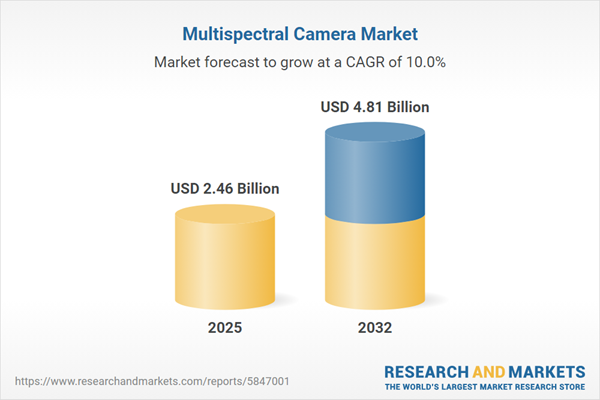Speak directly to the analyst to clarify any post sales queries you may have.
Multispectral imaging systems are reshaping data acquisition and analysis across multiple verticals, enabling sharper, data-driven decisions in mission-critical environments. Rapid technological advances and evolving applications are positioning the multispectral camera market as a cornerstone for organizations seeking higher operational precision and actionable intelligence.
Market Snapshot: Growth Trajectory and Strategic Context
The multispectral camera market grew from USD 2.25 billion in 2024 to USD 2.46 billion in 2025. Continuing at a CAGR of 9.97%, it is projected to reach USD 4.81 billion by 2032. Expanding deployments across agriculture, defense, research, and infrastructure monitoring underscore the relevance of multispectral solutions in the evolving data landscape. Innovations in miniaturization, sensor sensitivity, and integrated analytics are driving industry adoption, while end users focus on precision and resource optimization to address diverse operational challenges.
Scope & Segmentation of the Multispectral Camera Market
This report delivers detailed segmentation and analysis that matter most to decision-makers driving multispectral imaging adoption:
- Component Types: Data Storage/Communication Interfaces, Image Processing & Control Electronics, Optical Filters, Sensor Array
- Product Categories: Airborne Platforms, Ground-based/Stationary Solutions, Space & Satellite-based Equipment
- Spectral Bands: Long-wave Infrared, Mid-wave Infrared, Short-wave Infrared, Visible Light
- Lens Variations: Fixed Lens, Zoom Lens
- End-Use Categories: Payload, Portable Solutions
- Applications: Environmental Monitoring, Industrial & Infrastructure Monitoring, Natural Resource Management, Precision Agriculture, Research & Academic Applications, Security & Surveillance
- Industry Verticals: Aerospace & Defense, Agriculture & Forestry, Automotive & Transportation, Energy, Healthcare, Mining & Mineralogy
- Geographic Insights: Americas (North America: United States, Canada, Mexico; Latin America: Brazil, Argentina, Chile, Colombia, Peru), Europe, Middle East & Africa (Europe: United Kingdom, Germany, France, Russia, Italy, Spain, Netherlands, Sweden, Poland, Switzerland; Middle East: United Arab Emirates, Saudi Arabia, Qatar, Turkey, Israel; Africa: South Africa, Nigeria, Egypt, Kenya), Asia-Pacific (China, India, Japan, Australia, South Korea, Indonesia, Thailand, Malaysia, Singapore, Taiwan)
- Notable Companies: AgEagle Aerial Systems Inc., Basler AG, BaySpec, Inc., Carl Zeiss AG, CHN Spec Technology (Zhejiang) Co., Ltd, Collins Aerospace, Eoptic Inc., Exosens SA, Hamamatsu Photonics K.K., Hensoldt AG, JAI A/S, L3Harris Technologies, Inc., Leonardo DRS, Inc., LightPath Technologies Inc., Lytid SAS, Parrot SA, Raptor Photonics Ltd, RTX Corporation, Salvo Technologies Inc., Sentera Inc., SILIOS Technologies SA, Sony Corporation, Spectral Devices Inc., Spectricity NV, SZ DJI Technology Co., Ltd., TECNO MOBILE LIMITED, Teledyne Technologies Incorporated, Thales Group, Torontech Inc.
Key Takeaways for Senior Decision-Makers
- Emerging innovations in sensor arrays and optical filtering are elevating detection precision and expanding addressable applications for multispectral imaging systems.
- Integration of AI-driven image analysis has improved real-time feature extraction, enabling faster decision-making and reducing operational latency in high-stakes sectors.
- Miniaturized, modular components facilitate agile platform integration, supporting scalability between airborne, stationary, and satellite applications without full system redesigns.
- Environmental and infrastructure monitoring is seeing broader adoption, supported by advances that reduce installation footprint and enable continuous data collection in challenging locations.
- Collaborative alliances between technology leaders and sector specialists are accelerating the deployment of ready-to-use solutions tailored to specific regulations and mission profiles.
- Market incumbents are responding to shifting geopolitical and regulatory pressures with resilient procurement strategies, including localization, modular system architecture, and long-term supplier agreements.
Tariff Impact: Navigating New Regulatory and Cost Realities
Recent tariff measures enacted in the United States have increased the cost of critical multispectral camera components, particularly optical filters and advanced electronics. This has driven industry participants to diversify global sourcing, invest in regional assembly, and develop modular architectures to mitigate disruption. Companies are also leveraging strategic partnerships and regulatory engagement to pursue exemptions, protecting supply continuity and cost management across cross-border operations.
Methodology & Data Sources
This report is built on comprehensive secondary research, including technical publications and regulatory reviews, and is validated with primary interviews from system engineers, researchers, and product leaders. Key insights are triangulated using patent data, trade statistics, and expert panels, ensuring accurate, actionable intelligence for every market stakeholder.
Why This Report Matters
- Equip your teams with clear, segment-level visibility into multispectral imaging adoption drivers and technology advances relevant to your industry.
- Support strategic planning with actionable analysis of procurement risks, regulatory headwinds, and evolving competitive strategies in the global market.
- Unlock value-creation opportunities by optimizing integration architectures and supplier relationships that align with domain-specific user requirements.
Conclusion
Advances in multispectral imaging are reshaping operational decision-making across global industries. This report empowers stakeholders to align investments and partnerships with shifting technology and regulatory landscapes for sustained advantage.
Additional Product Information:
- Purchase of this report includes 1 year online access with quarterly updates.
- This report can be updated on request. Please contact our Customer Experience team using the Ask a Question widget on our website.
Table of Contents
3. Executive Summary
4. Market Overview
7. Cumulative Impact of Artificial Intelligence 2025
Companies Mentioned
The companies profiled in this Multispectral Camera market report include:- AgEagle Aerial Systems Inc.
- Basler AG
- BaySpec, Inc.
- Carl Zeiss AG
- CHN Spec Technology (Zhejiang) Co., Ltd
- Collins Aerospace
- Eoptic Inc.
- Exosens SA
- Hamamatsu Photonics K.K.
- Hensoldt AG
- JAI A/S
- L3Harris Technologies, Inc.
- Leonardo DRS, Inc.
- LightPath Technologies Inc.
- Lytid SAS
- Parrot SA
- Raptor Photonics Ltd
- RTX Corporation
- Salvo Technologies Inc.
- Sentera Inc.
- SILIOS Technologies SA
- Sony Corporation
- Spectral Devices Inc.
- Spectricity NV
- SZ DJI Technology Co., Ltd.
- TECNO MOBILE LIMITED
- Teledyne Technologies Incorporated
- Thales Group
- Torontech Inc.
Table Information
| Report Attribute | Details |
|---|---|
| No. of Pages | 180 |
| Published | November 2025 |
| Forecast Period | 2025 - 2032 |
| Estimated Market Value ( USD | $ 2.46 Billion |
| Forecasted Market Value ( USD | $ 4.81 Billion |
| Compound Annual Growth Rate | 9.9% |
| Regions Covered | Global |
| No. of Companies Mentioned | 30 |









